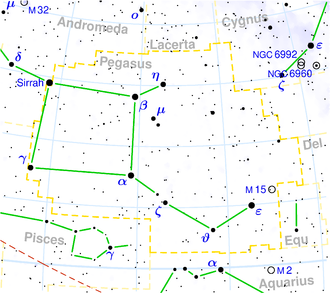NGC 7737
| Galaxy NGC 7737 |
|
|---|---|
![NGC 7737 with LEDA 1795655 (bottom left), [1] SDSS image](https://upload.wikimedia.org/wikipedia/commons/thumb/9/96/NGC7737_-_SDSS_DR14.jpg/300px-NGC7737_-_SDSS_DR14.jpg)
|
|
| NGC 7737 with LEDA 1795655 (bottom left), SDSS image | |
| AladinLite | |
| Constellation | Pegasus |
|
Position equinox : J2000.0 , epoch : J2000.0 |
|
| Right ascension | 23 h 42 m 46.41 s |
| declination | + 27 ° 03 ′ 10.6 ″ |
| Appearance | |
| Morphological type | S0 / a |
| Brightness (visual) | 13.9 likes |
| Brightness (B-band) | 14.8 mag |
| Angular expansion | 0.9 '× 0.4' |
| Position angle | 147 ° |
| Surface brightness | 12.7 mag / arcmin² |
| Physical data | |
| Affiliation | Abell 2634 |
| Redshift | 0.025478 ± 0.000033 |
| Radial velocity | 7638 ± 10 km / s |
|
Stroke distance v rad / H 0 |
(349 ± 24) x 10 6 ly (107.1 ± 7.5) Mpc |
| history | |
| discovery | Guillaume Bigourdan |
| Discovery date | October 3, 1886 |
| Catalog names | |
| NGC 7737 • UGC 12745 • PGC 72182 • CGCG 476-118 • MCG + 04-55-048 • 2MASX J23424642 + 2703107 • GALEX ASC J234246.41 + 270311.4 • LDCE 1595 NED002 • WISEA J234246.40 + 270310.4 | |
NGC 7737 is a lenticular galaxy of the Hubble type S0 / a in the constellation Pegasus in the northern sky . It is an estimated 349 million light years from the Milky Way and about 90,000 light years in diameter. Gravitational binding with PGC 72179 is possible .
In the same area of the sky are the galaxies NGC 7735 , NGC 7741 , NGC 7745 .
The object was discovered by Guillaume Bigourdan on October 3, 1886 .
